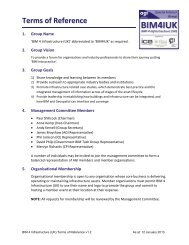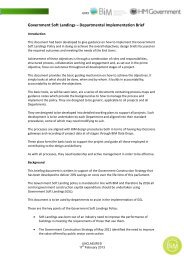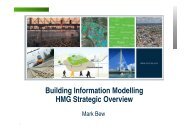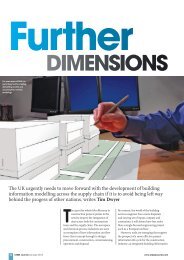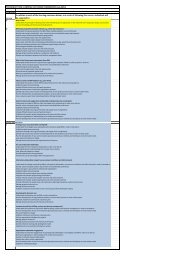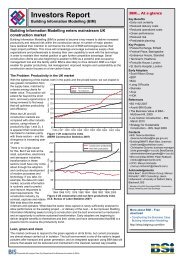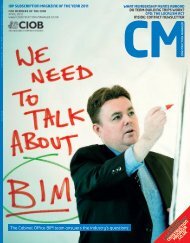Growth through BIM - Institution of Civil Engineers
Growth through BIM - Institution of Civil Engineers
Growth through BIM - Institution of Civil Engineers
- No tags were found...
Create successful ePaper yourself
Turn your PDF publications into a flip-book with our unique Google optimized e-Paper software.
the government <strong>BIM</strong> strategy, are likely to alter the service landscapeGovernment S<strong>of</strong>t Landings (GSL)for the pr<strong>of</strong>ession. Briefing will now include operational aspects andthe commissioning and post-handover operation <strong>of</strong> the facility will linkback to the designers and makers. More workload will come at Stages“S<strong>of</strong>t Landings” was defined by Cambridge University andits consultants Mark Way and Bill Bordass in 2005. It setout to ensure that its new buildings were well handed-overand easy to operate. Facility management requirementsbecome part <strong>of</strong> the brief, with enhanced duties at commissioningand handover, followed by team members in residencein the building for a period after occupation, to ironout problems. GSL adds digital tools and stresses feedback<strong>through</strong> data flow and in-use evaluation. It also seeks successfuloutcomes for users, not just good building physics.2 and 3, less at 4 and 5, more at 6 and new services at Stage 7, In-Use. Design simulation and analytical tools will need to migrate to a<strong>BIM</strong> basis, interoperable with other pr<strong>of</strong>essions’ models. Continuouschecking <strong>of</strong> designed performance is likely to be possible, rather than amajor check at a late stage. Client satisfaction is likely to improve considerably.Buildings are getting much more ICT installed nowadays, forboth building control and occupier business support. Previously separatetechnologies now share the Internet Protocol and it is likely thatspecialist firms will undertake both base building and occupier systemdesign and installation. The sensor-based Internet <strong>of</strong> Things will makebuilding control much more sophisticated.there are related product-based specialism which remain designer-constructors(eg for lifts and sprinklers). Practitioners move between consultancyand contracting. Free-standing pr<strong>of</strong>essional consultancies asa result are <strong>of</strong>ten tasked with limited services, the bulk <strong>of</strong> the workbeing included with the subcontractor design. This has not been whollysuccessful as sustainability has put more emphasis on the conceptualstage and its integration with the architectural and structural design<strong>of</strong> buildings. There has also been a long-standing issue about performance<strong>of</strong> services in use: systems have <strong>of</strong>ten not been fully commissioned,nor well operated and maintained, due to the fragmented procurementpattern. <strong>BIM</strong> and S<strong>of</strong>t Landings (ref 19), coupled together inServices Coordination in a hospitalG r o w t h t h r o u g h B I M57





